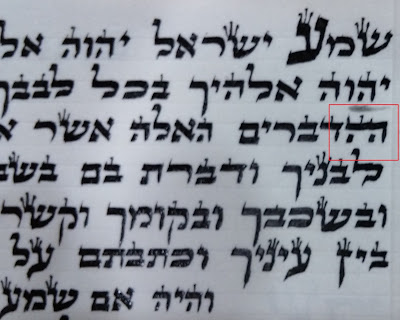ה"א עם שתי רגלים שמאליות
הסופר שכח למחוק את רגל שמאל של הה"א הראשונה אחר שמשך את הגג ועשה לה רגל שמאל חדשה !!!
האם הה"א כשרה כך??
ואם לא, האם מותר למחוק את הרגל הפנימית, או שזה פסול משום חק תוכות??
האם הה"א כשרה כך??
ואם לא, האם מותר למחוק את הרגל הפנימית, או שזה פסול משום חק תוכות??


מה השאלה, בודאי פסול ואי אפשר לתקן.
ReplyDelete@ Yankev:
ReplyDeleteBased on what do you say that? Do you have sources?
Here are some sources:
Gidulei hekdesh klal 15, s"k 13. He brings the Mishnas Avraham who cites Shu"t Sta"m and Yosef Daas who rule its Kosher!!!
The Gidulei hekdesh himself pasels.
See Rav Shterns Biur HaSofer on Siman 5, Os Hei.
Im not sure that this case would be passul even according to Gidulei Hekdesh... since 1)its not even a proper Yud 2) its in the half closer to the right foot.
His proof from Magen Avraham Siman 32 S"K 33 is objectionable since adding the second foot would be Shelo kesidran... as opposed to this Mezuzah where it was done kesidran.
So, maybe a Shaalas tinok would be in order?
I dont know.
I know this: my opinion is meaningless without sources:):):)
Could you imagine and extra-wide ח with three legs being kosher?
DeleteR' Yankev,
DeleteWith all due respect: IMAGINATION is not a factor in Halachah. Sources. Sources. Sources. Nothing short of that is relevant. Sta"m is a field of Halachah. Period.
This is an issue that I am deeply committed to and passionate about. In my 15 years doing this work I have seen far too many times people being machmir and meikil based on made up comparisons, imagination, and feelings. Rachmana Litzlan.
Now, just for purposes of conversation: Do you know that it is permissible to erase the extra head on a four-headed Shin according to Marika"sh? I know that we don't accept this psak as the Mishna Berurah rules in Mishnas Sofrim Os Shin. But do you know that R' Akiva Eiger brings this Marika"sh in his Chidushim in Shulchan Aruch in Siman 32?
Hardly anything can be considered so "obvious"...
In this case
1) It is not a proper Yu"d shape - a distinction that Rav Shtern discusses in the Biur Hasofer.
2) It is in the half closer to the right leg - a circumstance with is a cause for Kula when a lamed, for example, extends into a Chof peshutah.
I am not a Posek and have no final say on anything. However, I do know that nothing is a obvious as it may sometimes seem.
Did the Poskim under discussion have a source for what they said? I understand they were much greater than us, but at the end of the day all chiddushim start somewhere and have to be evaluated under the lens of Shas, Rishonim, Mesorah/history, סברא ישרה, etc. This forum is for preliminary discussion not for dissemination psak.
DeleteAlso I don't understand at all the idea to be more meikil if it's not a real yud shape. The yud shape is not a part of the basic tzurah of the regel of the ה; it's something the Ashkenazi rishonim bring as part of the mystical רמז of the form of the letter. Perhaps there would be more room to be meikil if it gave the impression of being an external dot as opposed to an additional regel. (Rav Stern alludes to this svora).
Also, your harping on my usage of the word 'imagine' was not to the point--I was obviously not saying that halacha should be determined by imagination; it was just a way of introducing a point to consider. Which I still think is a good one, especially because the difference between ה and ח in ancient ksav was quite minimal.
See Kesiva Tama. In addition to the Gedulei Hekdesh, Meir Eini Sofrim, MM, Kol Yaakov and Kol SOfrim pasel and Binyan Olam is in doubt. Lemaaseh, I believe we pasel this.
ReplyDeleteThank you R 'Yerachmiel.
ReplyDeleteI believe that M"M and Gidulei Hekdesh are the same author.
Thank you R 'Yerachmiel.
ReplyDeleteI believe that M"M and Gidulei Hekdesh are the same author.
I retract my comment. Since the regel is in the far right half, perhaps there's room to be mekel. A posek mumcheh should be consulted.
ReplyDeleteMM and GH are the same author. However, the Kesiva Tama brings sources from both seforim.
Thank you R' Yerachmiel.
DeleteI'd just like to correct you on your list of sources. The Meir Eini Sofrim is actually Meikil.
See here: http://www.hebrewbooks.org/pdfpager.aspx?req=40428&st=&pgnum=82
So: we have R' Shlomo Kluger, Yosef Daas, and Meir Eini Sofrim on the one hand that are Meikil. M"M (same as Gidulei Hekdesh), Kol Yaakov, and Kol Sofrim on the other hand. Shu"t Binyan Olam is in the middle.
This in addition to what we have both already pointed out: our case may be even more lenient as the extra foot is in the right half of the hei.
Thanks for pointing out that the MES is mekel. I misread the kesiva Tama. Even so, if it were on the left half, I think the poskim are machmir.
ReplyDelete